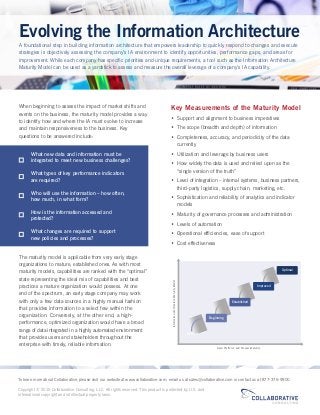Evolving The Information Architecture: Considerations Checklist
•
0 likes•214 views
A foundational step in building information architecture that empowers leadership to quickly respond to changes and execute strategies is objectively assessing the company’s IA environment to identify opportunities, performance gaps, and areas for improvement. While each company has specific priorities and unique requirements, a tool such as the Information Architecture Maturity Model can be used as a yardstick to assess and measure the overall leverage of a company’s IA capability.
Report
Share
Report
Share
Download to read offline

Recommended
A major business-to-business electronic components manufacturer, Analog Devices, Inc. (ADI), wanted to improve an engineering web application to enable its customers to design and configure electronic products.Infographic: Mission Impossible – Concept on a Napkin to Award-Winning Innova...

Infographic: Mission Impossible – Concept on a Napkin to Award-Winning Innova...Collaborative Consulting
Recommended
A major business-to-business electronic components manufacturer, Analog Devices, Inc. (ADI), wanted to improve an engineering web application to enable its customers to design and configure electronic products.Infographic: Mission Impossible – Concept on a Napkin to Award-Winning Innova...

Infographic: Mission Impossible – Concept on a Napkin to Award-Winning Innova...Collaborative Consulting
More Related Content
More from Collaborative Consulting
More from Collaborative Consulting (6)
Considerations Checklist: What is High Availability (HA)?

Considerations Checklist: What is High Availability (HA)?
Recently uploaded
Recently uploaded (20)
Future Visions: Predictions to Guide and Time Tech Innovation, Peter Udo Diehl

Future Visions: Predictions to Guide and Time Tech Innovation, Peter Udo Diehl
Integrating Telephony Systems with Salesforce: Insights and Considerations, B...

Integrating Telephony Systems with Salesforce: Insights and Considerations, B...
Where to Learn More About FDO _ Richard at FIDO Alliance.pdf

Where to Learn More About FDO _ Richard at FIDO Alliance.pdf
Custom Approval Process: A New Perspective, Pavel Hrbacek & Anindya Halder

Custom Approval Process: A New Perspective, Pavel Hrbacek & Anindya Halder
Introduction to FDO and How It works Applications _ Richard at FIDO Alliance.pdf

Introduction to FDO and How It works Applications _ Richard at FIDO Alliance.pdf
Behind the Scenes From the Manager's Chair: Decoding the Secrets of Successfu...

Behind the Scenes From the Manager's Chair: Decoding the Secrets of Successfu...
PLAI - Acceleration Program for Generative A.I. Startups

PLAI - Acceleration Program for Generative A.I. Startups
Optimizing NoSQL Performance Through Observability

Optimizing NoSQL Performance Through Observability
ASRock Industrial FDO Solutions in Action for Industrial Edge AI _ Kenny at A...

ASRock Industrial FDO Solutions in Action for Industrial Edge AI _ Kenny at A...
Simplified FDO Manufacturing Flow with TPMs _ Liam at Infineon.pdf

Simplified FDO Manufacturing Flow with TPMs _ Liam at Infineon.pdf
What's New in Teams Calling, Meetings and Devices April 2024

What's New in Teams Calling, Meetings and Devices April 2024
Evolving The Information Architecture: Considerations Checklist
- 1. To learn more about Collaborative, please visit our website at www.collaborative.com, email us at sales@collaborative.com or contact us at 877-376-9900. Copyright © 2015 Collaborative Consulting, LLC. All rights reserved. This product is protected by U.S. and international copyright and intellectual property laws. InformationArchitectureMaturityModel Data, Platform, and Process Maturity Without Established Improved Optimal Beginning Evolving the Information Architecture A foundational step in building information architecture that empowers leadership to quickly respond to changes and execute strategies is objectively assessing the company’s IA environment to identify opportunities, performance gaps, and areas for improvement. While each company has specific priorities and unique requirements, a tool such as the Information Architecture Maturity Model can be used as a yardstick to assess and measure the overall leverage of a company’s IA capability. When beginning to assess the impact of market shifts and events on the business, the maturity model provides a way to identify how and where the IA must evolve to increase and maintain responsiveness to the business. Key questions to be answered include: The maturity model is applicable from very early stage organizations to mature, established ones. As with most maturity models, capabilities are ranked with the “optimal” state representing the ideal mix of capabilities and best practices a mature organization would possess. At one end of the spectrum, an early stage company may work with only a few data sources in a highly manual fashion that provides information to a select few within the organization. Conversely, at the other end, a high- performance, optimized organization would have a broad range of data integrated in a highly automated environment that provides users and stakeholders throughout the enterprise with timely, reliable information. Key Measurements of the Maturity Model What new data and information must be integrated to meet new business challenges? What types of key performance indicators are required? Who will use the information – how often, how much, in what form? How is the information accessed and protected? What changes are required to support new policies and processes? • Support and alignment to business imperatives • The scope (breadth and depth) of information • Completeness, accuracy, and periodicity of the data currently • Utilization and leverage by business users • How widely the data is used and relied upon as the “single version of the truth” • Level of integration – internal systems, business partners, third-party logistics, supply chain, marketing, etc. • Sophistication and reliability of analytics and indicator models • Maturity of governance processes and administration • Levels of automation • Operational efficiencies, ease of support • Cost effectiveness
